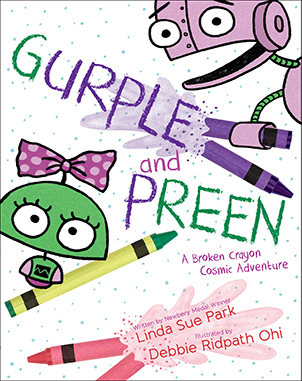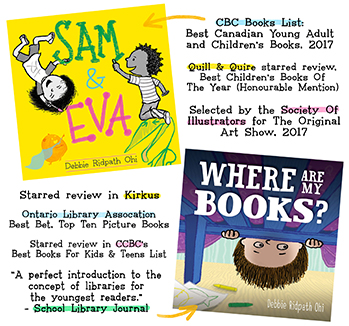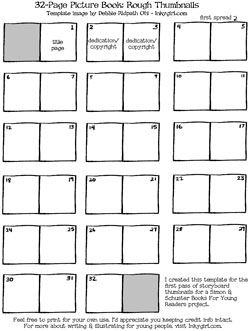Writing & Illustrating A Picture Book For Simon & Schuster Books For Young Readers (Part 2: Brainstorming, Story Pitch, Thumbnail Assignment)
Continuing my series on working with Simon & Schuster Books For Young Readers on two new books...
POSTS SO FAR: Part 1 - Part 2 - Part 3
(Summary: After I finished illustrations for I'M BORED, Simon & Schuster BFYR offered me two blank contracts. This series is about my own experience working with S&S BFYR on my two new books; if you're interested in the process for I'M BORED, please see How I'M BORED Was Created: A Guide For Young Readers. Neither of these series are meant to The Definitive Guide of how a picture book is created. Your own publishing experience may differ, depending on your situation and people involved. Thanks for following along! -- Debbie)
And here is what has happened so far:

I brainstormed picture book ideas.
I've been compiling picture book ideas for a while now, inspired by Paula Yoo's NaPiBoWriWee, Tara Lazar's PiBoIdMo and #KidLitArt's Picture Book Dummy Challenge. I've turned some of these into picture book manuscripts.
What I discovered: it's easy to come up with ideas for picture books. The challenge: to come up with picture book ideas that are different from anything else already out there.
This is one of the common misconceptions held by newbie picture book writers, I find: that their story is unique. I still consider myself a newbie picture book writer, by the way, so I speak from experience.
Child nervous about their first day at school but then finds out another child feels the same / makes new friends / discovers it's not so bad after all? Done.
 Child has trouble making new friends because they are too shy / insecure / mean / stubborn / family just moved? Done.
Child has trouble making new friends because they are too shy / insecure / mean / stubborn / family just moved? Done.
Child loses a beloved object / pet / toy and is totally distraught but then formulates plan / enlists help / searches everywhere? Done.
Child having a horrible day where nothing goes right but then takes action & everything turns out ok? Done.
Child resents the fact that he is always overlooked / ignored and decides to do something about it? Done.
Child hates doing something that parents always want her to do so finds a way around it but then discovers why it was a good idea? Done.
Child resents older or younger sibling so decides to run away / get rid of sibling somehow but starts missing the sibling despite himself and reunites? Done.
Child...well, you get the idea.
The bottom line: It's very tough to come up with a story that is totally unique.
But still:
I tried to figure out how to make my story stand out in the marketplace.
At this point, I can already imagine some of you shaking your fingers at me and saying, "Just focus on making a good story. Worry about the marketing/publishing part later."
However, I'm already assuming that having a good story is an essential. My end goal, however, is to not only get the book published but to have the book sell well. If the story is too much like others already out there, a publisher is less likely to want to take a risk on it. And if the book doesn't sell well, then the publisher is less likely to offer me more contracts.

So yes, there needs to be a good story BUT I also want to help an editor convince their sales team that the book should be published.
An aside: I've already gone through this several times with my novels for young people, in which various editors liked my story enough to take to the next step, but then the projects were nixed by sales/marketing. It's one reason I spent way more time in the plotting/outlining process for my current YA mss before starting to actually write it (and it got nominated for an SCBWI Sue Alexander "Most Promising For Publication Award"! It didn't win...but still! Now I just need to finish it).
So yes, I was discouraged. But then I thought, hold on. Surely I can't be the only one despairing about finding a unique story idea. And there are new picture books coming out all the time!
And that brings to me to another essential part of my "newbie picture book writer/illustrator" self-education:

I read many, many picture books.
Since the career-changing events of 2010, I've been immersing myself in the world of picture books. I have no children and hadn't really read many picture books since my nephews and nieces grew past that stage.
Once Simon & Schuster BFYR offered me my first picture book illustration contract, that all changed. I started going to the library and local bookstores every week to read as many picture books as I could. I read everything I could get my hands on -- old and new.
I looked at both the text and the illustrations, and how they enhanced each other. I didn't always like the picture books I read, but tried to analyze exactly WHY I didn't like them. And when I really enjoyed a picture book, then I'd reread it and ask myself similar questions: WHY did I like it?
I needed to figure out a unique spin for my stories.
I looked especially closely at new releases. Obviously these publishers had faith in these books, so what was it about the stories that made the publishers willing to invest money into these projects? The answer: a unique spin. In almost every case, the basic story was enhanced with a framework made unique in either the setting, characters, voice, format or other aspect.
Once I realized this, I went over my list of picture book stories and started working on expanding some of them into full manuscripts with the whole "unique spin" aspect in mind.
But still, I wasn't completely happy with any of them yet.
I realized that I needed to get my head into "pitch" mode.
 When I last visited Simon & Schuster BFYR in NYC to talk about I'M BORED promotion, Justin asked me if I had any picture book stories to show him. I hesitated, saying that I had written about 25 picture book manuscripts but wasn't yet happy with any of them.
When I last visited Simon & Schuster BFYR in NYC to talk about I'M BORED promotion, Justin asked me if I had any picture book stories to show him. I hesitated, saying that I had written about 25 picture book manuscripts but wasn't yet happy with any of them.
Justin interrupted my babbling excuses and suggested that I needed to change my mindset. Having worked with S&S BFYR on I'm Bored, I already had my foot in the door. Simon & Schuster Books For Young Readers was my publisher. He was my editor. So how about I pick out 4-5 of what I considered my best stories and send them to him, even if I didn't think they were perfect yet?
Whoa. Really?!?
Ok, I admit I was pretty clueless. I had figured that even though I had illustrated a book for S&S BFYR, that I was still starting from scratch when it came to submitting my own stories. And that if they said no, that was it.
I was wrong.
Anyway, I promised Justin I'd send something very soon. Of course I was STILL paranoid about sending stories that I considered early drafts, so I enlisted the help of my MiG Writers critique group for some feedback and suggestions for tweaks.
Then...I took a deep breath and send my stories to Justin.
He picked one he thought had the most potential. I'm very happy he picked the idea that he did; of all the stories I sent him, this is going to be the most fun to draw!
We had a phone meeting about my story, with editorial assistant Dani Young sitting in. It was a TRULY EXCELLENT phone meeting. I was all "omigod, you're absolutely RIGHT" and "YES! I love that!!" and Justin was all "it's all right there in your story" (I just hadn't seen it).
What Justin was able to do, which I hadn't, was to identify the essence of my picture book as well as see the potential of what it could be. AND he was able to communicate that to me.
By the end of the phone call, I was incredibly inspired and eager to get started.
THE NEXT STEP: I need to show my story visually, in thumbnails.
Justin asked me to forget about working on the text but just to focus on figuring out how to tell my story visually in very rough thumbnail sketches -- knowing that will help determine my text. I'm not going to worry about character sketches or detailed illustrations yet.
To do this, I've created a template which fits on an 8.5 x 11 sheet of paper. In case any of you would like to use it for your own picture book planning, I've provided a print-ready PDF version (click thumbnail below):
There seem to be many different templates for book dummies out there, but I wanted to make sure I was using one that Justin approved since I'll be printing out quite a few copies for me to scribble on. Justin said the endpapers are separate for a 32-page book, so I'm not going to worry about those for now.
I've filled up nearly a dozen of these sheets with my scribbled thumbnails already. Working out a story this way is GREAT for exposing bad pacing and other storytelling problems; I've already discovered that the mss I sent Justin just doesn't work. I'm working non-digitally for these sketches using just a pile of printed sheets, a mechanical pencil and a big eraser. The eraser is getting a LOT of use. :-)
Even if you don't draw but are just writing a picture book story, I still recommend you try this method. Just use stick figures or a scribbled phrase (e.g. "Sam throws marmite at Emma" etc.).
Other resources you might find helpful:
Bob Staake's Picture Book Templates (though reader Michael Johnson had issues with that template and proposed a revision)
Tara Lazaar's Picture Book Layout Dummy
How To Mock Up A Picture Book, by Darcy Pattison
FAQ: Making A Picture Book Dummy, by Tina Burke
How To Make A Storyboard, by Uri Shulevitz
If you know any other resources that could help picture book writer/illustrators in the early creation stages, feel free to post below!
There is no set schedule to this blog post series. I'll only post in the series if I have something useful or interesting to say. To make it easier to follow this particular thread, I'll tag related posts with "pbcreation."














 Tuesday, May 15, 2012 at 10:39 AM
Tuesday, May 15, 2012 at 10:39 AM
Reader Comments (10)
It's nice, Debie, to read the process. I'm curious why editors accepted your previous ideas for picture books, but sale/marketing rejected it. I thought that editors will also knwo what will sell or not. Is your iullstration for the currentbook will be in the same style as for "I'm Bored."? (great concept for a book). Thanks and best wishes from the same city, Giora
Thank you for your post. You are so correct about finding a unique story. I keep writing picture books that have already been written. Then again, there are people that believe that there are no new stories left or that every story is essentially the same story. I'm off to try to prove them wrong.
You have provided some very useful information. In developing a story, I often work back and forth between illustrations and text. Sometimes at first, this process is a struggle, but then the story begins to fall into place. Having a visual story board helps me move the story forward and know what is working and what is not. Thanks for your post, Beryl
Julie: Good luck! I'm rooting for you. :-)
Beryl: I'm glad you enjoyed my post and thanks for sharing your own experience.
I strongly suspect that as it grows, this series of posts will become an incredibly valuable resource for those seeking a real view of the field. For the sake of other authors-to-come, I hope you have the time to keep the series going. (The series might also make a fine mini-book when the picture book is finally published - the "making of"!)
I'll admit, I'm finding it fascinating, and I have no interest in being an author (it's way too hard work...)
Giora: My novels have been rejected for various reasons over the years. In the later years, they almost always made it past the initial reading stage but got nixed at some point past that. When sales/marketing ultimately said no, it was usually because of one of the following reasons: (1) it was too much like another title that was coming out around the same time, (2) it was too similar to another title in their backlist, or (3) it was felt that my story wouldn't stand out enough in the marketplace.
The last was the most common reason given. Most of the editors liked my writing, so I knew that what I really needed to work on was a stronger story. And that's what I have been working to improve in my novel writing. :-)
Now that my craft is improving, I'm actually glad that those editors rejected my books. I'm a much better writer now, and I continue to work to improve.
Someday, I hope to have my novels for young people out there in addition to my picture books. It's one of my goals for the near future!
p.s. In answer to your question about my illustration style -- It's too early to say what kind of style I'll be using for these two new picture books I have with S&S BFYR. I have multiple styles, and it will depend on the final manuscripts.
Right now I'm working on the story for my own picture book.
As for the new picture book that S&S has contracted me to illustrate (that someone else writes), I'm eagerly waiting to find out what that story will be. :-) I know they're looking for an appropriate manuscript right now, so fingers crossed...
Thanks for doing this and future blog posts. I am just a beginning author. It is nice to hear about your experience, trials and tribulations.
This is fantastic! Looking forward to the next post! I read so many PBs that the lbrarians are happy when I come to pick up my holds...and free up the sagging shelf. I also sort them into piles, judging by their covers for even more marketing insight. I am curious that you are not yet sure of the illustration styles you will use - I had 'heard' the publisher likes the illustrator to have ONE (...there can be only one...). Is that not the case?
Thanks so much for detailing this process! It's so cool that you have a wonderful editor to work with. I look forward to your next post!
Thank you for sharing your expertise and talent. INKYGIRL has a voice that is supportive. Instead of being daunted or overwhelmed, the step by step, friendly explanations are gold. #IINKYGirl:confident and encouraging